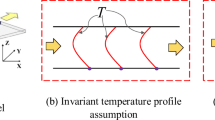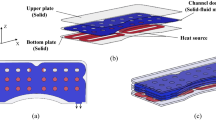Abstract
To design effective and easy-to-manufacture conductive heat channels, a heuristic method by emulating the natural branch systems is suggested. The design process of the method is divided into two steps, which are the principal channel design and the lateral channel design. During the process, the width of each channel is controlled by the bifurcation law, and the end point of the channel is located at the point with the maximum temperature while the start points of the principal channel and the lateral channel are respectively determined by the location of the heat sink and the law of the minimum thermal resistance. Four design examples with different boundary conditions are studied by the suggested method, and the design results are compared with that of the traditional structural topology optimization method. Not only lower maximum temperature and relatively uniform distribution of temperature are obtained by the suggested method, but also straight channels are achieved without gray element, which is easy to manufacture. The suggested method inspired by the natural branch systems can provide an effective solution for heat channel design in the heat dissipation structures.
Similar content being viewed by others
References
Guo K, Qi W Z, Liu B T, Liu C J, Huang Z Q, Zhu G M. Optimization of an “area to point” heat conduction problem. Applied Thermal Engineering, 2016, 93, 61–71.
Hannemann R J. Thermal control of electronics: Perspectives and prospects. Proceedings of Rohsenow Symposium, Massachusetts, USA, 2003, 1–6.
Zhang X F, Chen X. Radiating technology of power electronics. Electronics & Packaging, 2007, 7, 35–39.
Zhang Y, Liu S. Design of conducting paths based on topology optimization. Heat & Mass Transfer, 2008, 44, 1217–1227.
Shabany Y. Heat Transfer: Thermal Management of Electronics, China Machine Press, Beijing, China, 2013. (in Chinese)
LI Q Y, Wang W, Zhou G Y. Status of techniques on heat dissipation in electronic components. Journal of Electron Devices, 2005, 28, 937–941.
Guo K, Qi W Z, Liu B T, Liu C J, Huang Z Q, Zhu G M. Optimization of an “area to point” heat conduction problem. Applied Thermal Engineering, 2016, 93, 61–71.
Hannemann R J. Thermal control of electronics: Perspectives and prospects. Proceedings of Rohsenow Symposium, Massachusetts, USA, 2003, 1–6.
Zhang X F, Chen X. Radiating technology of power electronics. Electronics & Packaging, 2007, 7, 35–39.
Zhang Y, Liu S. Design of conducting paths based on topology optimization. Heat & Mass Transfer, 2008, 44, 1217–1227.
Shabany Y. Heat Transfer: Thermal Management of Electronics, China Machine Press, Beijing, China, 2013. (in Chinese)
LI Q Y, Wang W, Zhou G Y. Status of techniques on heat dissipation in electronic components. Journal of Electron Devices, 2005, 28, 937–941.
Dbouk T. A review about the engineering design of optimal heat transfer systems using topology optimization. Applied Thermal Engineering, 2016, 112, 841–854.
Bejan A. Shape and structure, from engineering to nature. Entropy, 2001, 3, 293–294.
Bejan A. Constructal-theory network of conducting paths for cooling a heat generating volume. International Journal of Heat & Mass Transfer, 1997, 40, 799–811.
Bendsøe M P, Kikuchi N. Generating optimal topologies in structural design using a homogenization method. Computer Methods in Applied Mechanics & Engineering, 1988, 71, 197–224.
Zhuang C G, Xiong Z H, Ding H. A level set method for topology optimization of heat conduction problem under multiple load cases. Computer Methods in Applied Mechanics & Engineering, 2007, 196, 1074–1084.
Xie Y M, Huang X D, Zuo Z H, Tang J W, Rong J H. Recent advances in evolutionary structural optimization (ESO) and bi-directional evolutionary structural optimization (BESO). Advances in Mechanics, 2011, 41, 462–471. (in Chinese)
Zhao L, Chen W Y, Ma J F, Yang Y B. Structural bionic design and experimental verification of a machine tool column. Journal of Bionic Engineering, 2008, 5, 46–52.
Ding X H, Yamazaki K. Adaptive growth technique of stiffener layout pattern for plate and shell structures to achieve minimum compliance. Engineering Optimization, 2005, 37, 259–276.
Li B T, Yan S N, Lin Q Y. Automated layout design of stiffened container structures based on the morphology of plant ramifications. Journal of Bionic Engineering, 2016, 13, 344–354.
Metzger R J, Klein O D, Martin G R, Krasnow M A. The branching programme of mouse lung development. Nature, 2008, 453, 745–750.
Runions A, Lane B, Prusinkiewicz P. Modeling trees with a space colonization algorithm. Proceedings of Eurographics Workshop on Natural Phenomena, Prague, Czech Republic, 2014, 63–70.
Lynch J P, Kai L N, Davis R D, Jablokow A G. SimRoot: Modelling and visualization of root systems. Plant & Soil, 1997, 188, 139–151.
Runions A, Fuhrer M, Lane B, Federl P, Rollandlagan A, Prusinkiewicz P. Modeling and visualization of leaf venation patterns. ACM Transactions on Graphics, 2005, 24, 702–711.
Camburn B, Otto K, Dan J, Crawford R, Wood K. Designing biologically inspired leaf structures: Computational geometric transport analysis of volume-to-point flow channels. Engineering with Computers, 2015, 31, 361–374.
Peng Y, Liu W Y, Chen W, Wang N L. A conceptual structure for heat transfer imitating the transporting principle of plant leaf. International Journal of Heat & Mass Transfer, 2014, 71, 79–90.
Lohan D J, Dede E M, Allison J T. Topology optimization for heat conduction using generative design algorithms. Structural and Multidisciplinary Optimization, 2017, 55, 1063–1077.
Xia Z Z, Cheng X G, Li Z X, Guo Z Y. Bionic optimization of heat transport paths for heat conduction problems. Journal of Enhanced Heat Transfer, 2004, 11, 119–132.
Ding X H, Yamazaki K. Constructal design of cooling channel in heat transfer system by utilizing optimality of branch systems in nature. Journal of Heat Transfer, 2007, 129, 245–255.
He J K, Mao M, Li D C, Jin Z M. Characterization of leaf-inspired microfluidic chips for pumpless fluid transport. Journal of Bionic Engineering, 2014, 11, 109–114.
Li B T, Hong J, Liu Z F. Stiffness design of machine tool structures by a biologically inspired topology optimization method. International Journal of Machine Tools & Manufacture, 2014, 84, 33–44.
Bejan A. Constructal Theory of Social Dynamics, Springer, Berlin, Germany, 2007, 71–83.
Murray C D. The physiological principle of minimum work: I. The vascular system and the cost of blood volume. Proceedings of the National Academy of Sciences of the United States of America, 1926, 12, 207–214.
Duan X B, Li F F, Qin X Q. Topology optimization of incompressible Navier–Stokes problem by level set based adaptive mesh method. Computers & Mathematics with Applications, 2016, 72, 1131–1141.
Maruyama S. Heat Transfer. Peking University Press, Beijing, China, 2011, 7.
Sherman T F. On connecting large vessels to small. The meaning of Murray’s law. Journal of General Physiology, 1981, 78, 431–453.
Miguel A F. Fluid flow in a porous tree-shaped network: Optimal design and extension of Hess–Murray’s law. Physica A Statistical Mechanics & Its Applications, 2015, 423, 61–71
Acknowledgments
This work is supported by the Chinese National Natural Science Fund (Grant No. 51175347). The support is gratefully acknowledged.
Author information
Authors and Affiliations
Corresponding author
Rights and permissions
About this article
Cite this article
Ji, Y., Ding, X., Li, H. et al. Layout Design of Conductive Heat Channel by Emulating Natural Branch Systems. J Bionic Eng 15, 567–578 (2018). https://doi.org/10.1007/s42235-018-0047-3
Published:
Issue Date:
DOI: https://doi.org/10.1007/s42235-018-0047-3




